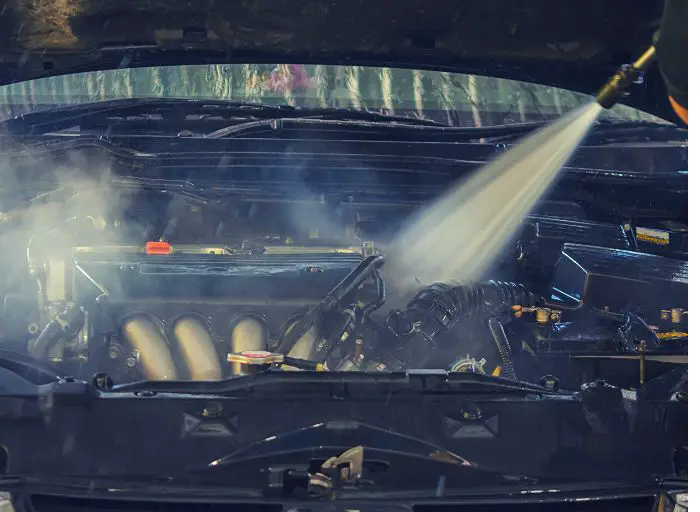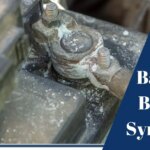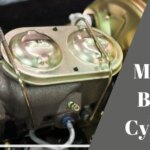
Even though the engine bay is extremely sensitive to water, many drivers can’t stop cleaning it. Unfortunately, while some may feel their cars are spotless inside and out, many report that their cars have started to operate poorly. As a result, I’ll outline the causes of car running rough after washing engine in this blog post and how to wash the engine bay properly.
Table of Contents
Reasons Car Running Rough After Washing Engine
If your car experiences rough running, trouble to start, or the check engine light comes on after cleaning the engine compartment. In most cases, you can look at the codes it displayed to determine where the issue might be. The following are potential causes:
#1 Mass airflow sensor (Code: PO100)
One of the most frequent reasons for rough engine operation after washing is this. As you are aware, the engine bay has a number of electrical connections that need to be secured before washing.
The engine may sputter, and the check engine light will come on if the water damages the mass airflow sensor.
How to fix it
You can now clean the sensor again and reset the check engine light.
- The mass airflow sensor must first be removed from the intake hoses. It was either clogged or damp.
- After that, use a mass airflow sensor cleaner to clean the sensor. Spray the cleaning solution all over the sensor.
- After giving it some time to dry, you can reassemble it. Reorient the sensor so that it is facing the proper way. It has an arrow on it to point in the right direction.
- Lastly, to clear the code, you should reset the ECU.
Keep in mind: avoid using WD-40.
#2 Spark plug holes with water
This is yet another reason why we are having this problem. Once the water has entered the spark plug holes, starting your car will become challenging. A spark plug may not generate enough spark to ignite the spark if there is too much water between the housing and the ceramic insulator.
How to fix it
After removing the spark plug, use compressed air to dry everything out.
#3 Other electrical connections
Since the engine bay has numerous electrical connections, if you can’t locate the issue, you can WD-40 all the electrical connections you can see and tighten them up.
How to Safely Clean the Engine Bay
Choose a warm, dry day to clean the engine bay after deciding to do so. Remember to wash the engine after it has cooled. If your engine is hot, wait at least 15 minutes with the hood open. In addition to burning you, hot engine parts can be damaged by quick contraction if they are sprayed with cool water.
Needed items:
- Plastic bags
- A degreaser
- A small brush
- Power washer
- Compressed air (optional)
Here are thorough directions for carefully cleaning the engine bay:
Step 1: Take off any plastic hood covers
You can clean each of these plastic covers separately. Remove the battery’s negative terminal as well. This will reduce the likelihood that moist electrical components will result in damage. You can also take the battery out to clean the engine bay if you’d like.
Step 2: Protect all delicate electrical parts
Cover delicate electrical parts with plastic bags, including the battery, ignition cables, and engine control unit. You should also cover any exposed engine air intakes if there are any under the hood.
Of course, you can omit this step if you think you’ll be extremely careful when rinsing. However, by safeguarding these electronics, you may clean them more thoroughly while running a lower risk of causing any harm.
Step 3: Spray the degreaser
Spray degreaser liberally around the whole engine compartment. Any household degreaser will function, including those designed specifically for cleaning engines or kitchen appliances. Don’t hold back; cover every square inch completely.
Step 4: Scrubbing
You might not need to scrub depending on how filthy your engine is. The valve cover, for example, may have years’ worth of caked-on grime and oil. To effectively work the degreaser in and remove the muck, use a small brush with synthetic—not metallic—bristles. If necessary, add a degreaser.
Step 5: Rinse each container well
A regular hose will also work, however, you can use your power washer on a low setting. Then, working from back to front, rinse the entire compartment to remove all degreaser. Avoid spraying water directly onto electrical components and avoid flooding regions that won’t dry quickly.
Step 6: Allow it to dry
If you have access to compressed air, you can blow air into the cracks and crevices to drain more water. If not, use a shop towel or rag to wipe everything you can reach. This will help remove any lingering filth in addition to removing the water.
Step 7: Remove coverings
Remove the bags covering the electrical components and reinstall the battery’s negative terminal.
Tip: Preventing your engine compartment from becoming very unclean in the first place is the key to making this project straightforward. Your engine will look cleaner with just an hour of effort each year or two of rapid degreasing.
Benefits of Engine Cleaning

A well-kept engine bay makes a used automobile appear newer and more cared for. Here are a few advantages of cleaning engines:
Aesthetic
The main benefit will probably be the clean engine’s aesthetic attractiveness. Buyers expect to find a clean engine when they shop because most used vehicles are meticulously maintained before being placed for sale. A used car’s curb appeal can suffer if its engine is unclean.
Avoid costly repairs
Engine cleaning identifies the source of oil or grease, such as a faulty valve-cover gasket, allowing a tiny issue, such as a little oil leak, to be isolated and fixed before it becomes more significant.
Additionally, using a degreaser to remove the gunk may save on repairs because oil and grease can hasten the wear of rubber hoses and plastic components. And a clean engine means your hands and clothes are less likely to become soiled if you like to perform small maintenance, like checking the oil level or accessory belts.
FAQs
Can you damage your engine by washing it?
It varies. No, if you know how to wash it correctly. Your engine is kept secure.
Wires, sensors, and other delicate engine parts may be exposed to water if cleaned incorrectly. In this case, water damage may cause the parts to malfunction, necessitating expensive engine part replacements or repairs.
How long should you wait after washing your engine?
After washing, leaving the car with the hood open for 30 to several hours is advisable to air dry.
How do I dry my engine after washing it?
On a warm day, you can let it air dry. Alternatively, you might dry it off with the air compressor.
Does cleaning your engine make it run better?
No data support the idea that a clean engine performs better than a dirty engine. It’s improbable that anything as straightforward as a little cleaner or degreaser could improve a car’s performance. However, as said previously, engine cleaning does have some advantages.
Hi there! I’m Naomi O’Colman. I’ve got years of experience working at an auto repair shop here in Texas under my belt. On top of that, ever since I was a kid I’ve been passionate about the auto industry. Since I’ve joined the team at automotivegearz.com I’ve been enthusiastically sharing my passion and insights with my readers. I’m dedicated to delivering high quality content and helping you stay up to date with the latest automotive trends and products out there!







